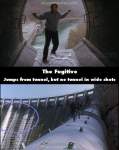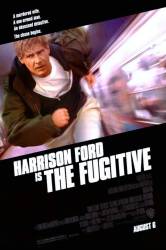Continuity mistake: In the flashbacks seen at the start of the film, Charles Nichols introduces Kimble to Alec Lentz. When this flashback is revisited later in the film, when Kimble breaks into Frederick Sykes' house, the words and actions of Nichols and Lentz are slightly different to what was seen earlier in the film. (00:04:15 - 01:24:55)
Continuity mistake: During the bus accident, Richard Kimble is handcuffed. When the bus is falling, you can see that he has no handcuffs on, but then when he asks the guard to uncuff him again, he has them back on. (00:16:20)

Continuity mistake: When Kimble goes back to the hospital as a janitor to check the hospital computer, the lady working in the lab is wearing two different dresses. (01:05:15)
Continuity mistake: When Kimble is on the moving train, Sykes mysteriously appears from a door when he wasn't there before. (02:00:00)
Continuity mistake: Kimble dyes his hair very dark to escape detection and dyed hair fades over time. For the rest of the movie his hair noticeably goes from darker shades to lighter shades and back again showing that the scenes were shot non-sequentially on different days with a fair amount of time in between.
Continuity mistake: After Richard Kimble first escapes they say he is near Route 15 and Interstate 57 heading towards Berkeley Dam. All these places exist, but Barkley Dam (Kentucky) is around a hundred miles away from these two roads (Illinois), and besides, Berkeley Dam looks nothing like what they show in the movie.
Continuity mistake: When the bus full of prisoners rolls down the embankment, it finishes up lying parallel to the train track. Yet in the next scene, the bus is clearly lying across the train track.
Continuity mistake: When Kimble is calling his lawyer close to the EL-train, he says something and then you hear the "clang" from the train's bell. You only hear it once. However, when the police records the call and plays it, the clang sounds almost constantly during the conversation.
Continuity mistake: In one scene, the ambulance is clearly marked FDNY even though the action takes place in Chicago.
Continuity mistake: When Richard Kimble and the one armed man are fighting in the train, it shows from the outside of the train the one armed man stumbling backward. It shows his "prosthetic" hand grabbing for the pole.

Continuity mistake: Kimble dives from the top of the dam when Gerard traps him in the tunnel. But in wide shots of Kimble falling, there's no tunnel above the dam. (The tunnel scenes were shot in Chicago, but the location sequences were done at Cheoah Dam in North Carolina - which has no tunnels. The end of the tunnel from which Harrison Ford supposedly jumped was built on the back of a large flatbed truck which was driven out on the top of the dam for the scene).
Continuity mistake: When Kimble is fighting the one-armed man on the train, the one-armed man shoots the metro-cop, then he and Kimble fight some more. Kimble knocks him out with his gun (silver). He goes to check on the cop, sees he's dead so he takes his cuffs and gun (black). He cuffs the one-armed man to the rail puts his gun (silver) into his right pocket, and the cops gun (black) into his left pocket, and then makes his escape. Later on, he dumps the guns into a mailbox, but he pulls the silver gun out of his left pocket, and the black gun out of his right pocket. The guns changed pockets before he dumped them.
Continuity mistake: Kimble runs out the Grand Ballroom and ends up in the Presidential Suite in another fight. The doors he goes through out of the Ballroom actually lead into the Foyer for the Continental Ballroom, both of which are on the second floor. That Presidential Suite is on the 27th Floor.
Continuity mistake: During the scene where Kimble is running from the dam, his hair is all messy and wet. yet, when he falls over into the leaves several shots later, his hair is nicely combed with a parting.
Continuity mistake: When Richard Kimble is being chased by Tommy Lee Jones in the St. Patrick's Day parade, there are three clock shots (on sides of buildings and whatnot), all of which show totally different times.
Continuity mistake: After Kimble escapes from the prison bus moments before it's demolished by a train, he steals an ambulance, is chased through the mountains by a police helicopter, is trapped in a tunnel, escapes by crawling through a drain and jumping from a very tall dam into a raging river. A very thrilling sequence, but he's supposed to be in Illinois, where there is no terrain remotely resembling this.
Continuity mistake: During the scene in the dam tunnels, Kimble holds Gerard at gunpoint. In the first close-up, Gerard has three strands of hair that are all apart from each other. The shot cuts to Kimble and back to Gerard, and the strands are all together. Then it goes back to Kimble, who says "I didn't kill my wife." When it goes back to Gerard again, the strands are apart once more. We know he couldn't have moved them because he has his hands up. Later, when Gerard is holding up Kimble at the tunnel opening, there is only one strand on his forehead.
Continuity mistake: The scene in which Kimball in Cook County Hospital takes Joel to the lift starts with Kimball looking at the boys chest x-rays. In the first shot Kimball is looking at the front side of it and in the second shot (with camera looking over his shoulder) at the back-side but he does not let the x-ray out of his hand between the shots.
Continuity mistake: When Richard Kimble comes back to the hospital and is seen by the nurse, they embrace. There is a shot with him facing the camera immediately followed by a shot of her facing the camera. Their arms have somehow magically changed positions from the original embrace.
Continuity mistake: When Kimble goes to the hospital to see Dr. Kathy Wahlund (looking into a microscope), she hugs him around his neck - in the next shot her arms are in a different spot.






Answer: It's a cold compress. You squeeze it, and the inner bag breaks mixing chemicals and it gets very cold. It helps to minimize swelling. He gave it to Kimball for all the bruises he had.
Grumpy Scot